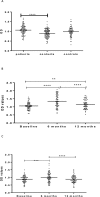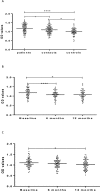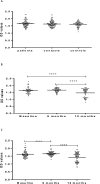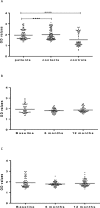IgA and IgG against Mycobacterium tuberculosis Rv2031 discriminate between pulmonary tuberculosis patients, Mycobacterium tuberculosis-infected and non-infected individuals
- PMID: 29373577
- PMCID: PMC5786301
- DOI: 10.1371/journal.pone.0190989
IgA and IgG against Mycobacterium tuberculosis Rv2031 discriminate between pulmonary tuberculosis patients, Mycobacterium tuberculosis-infected and non-infected individuals
Abstract
As part of a major project to investigate protective and diagnostic immune markers against tuberculosis (TB), we measured antibody isotype responses to Mycobacterium tuberculosis (Mtb) antigens (LAM, Rv2031, and HBHA) in cohorts of 149 pulmonary tuberculosis patients (PTBP), 148 household contacts (HHCs), and 68 community controls (CCs) in an endemic setting. ELISA was used to measure levels of IgA, IgG, and IgM from sera of cohorts at baseline, and at 6 and 12 months from entry. The results show that there were significant differences in IgA, IgG, and IgM responses to the different antigens and in the three cohorts. At baseline, the level of IgM against RV2031 and LAM did not vary between cohorts, but the levels of IgA and IgG against Rv2031 were significantly higher in PTB patients than HHCs and CCs, followed by HHCs, and the lowest in CCs. In patients, there was a significant variation in antibody responses before and after chemotherapy. The levels of IgA and IgG against HBHA, and IgA against Rv2031 decreased significantly and remained low, while IgA and IgG against LAM increased significantly and remained high following chemotherapy. However, the levels of IgM against Rv2031 and LAM increased at 6 months but decreased again at 12 months. IgM against HBHA did not show any significant variation before and after chemotherapy. Similarly, there were also significant variations in antibody responses in HHCs over time. Our results show that there are significant variations in IgA, IgG and IgM responses to the different antigens and in the three cohorts, implying that not all antibody isotype responses are markers of clinical TB. In addition, the current and previous studies consistently show that IgA and IgG against Rv2031 discriminate between clinical disease, Mtb-infected and non-infected individuals.
Conflict of interest statement
Figures








Similar articles
-
IgA response to ESAT-6/CFP-10 and Rv2031 antigens varies in patients with culture-confirmed pulmonary tuberculosis, healthy Mycobacterium tuberculosis-infected and non-infected individuals in a tuberculosis endemic setting, Ethiopia.Scand J Immunol. 2013 Sep;78(3):266-74. doi: 10.1111/sji.12080. Scand J Immunol. 2013. PMID: 23713613
-
Pro- and anti-inflammatory cytokines against Rv2031 are elevated during latent tuberculosis: a study in cohorts of tuberculosis patients, household contacts and community controls in an endemic setting.PLoS One. 2015 Apr 21;10(4):e0124134. doi: 10.1371/journal.pone.0124134. eCollection 2015. PLoS One. 2015. PMID: 25897840 Free PMC article.
-
[Evaluation of humoral immune response against mycobacterial antigens in bronchoalveolar lavage fluid from patients with pulmonary tuberculosis confirmed by genetic and culture methods].Pneumonol Alergol Pol. 2007;75(4):355-62. Pneumonol Alergol Pol. 2007. PMID: 18080985 Polish.
-
Distinct and shared B cell responses of tuberculosis patients and their household contacts.PLoS One. 2022 Oct 25;17(10):e0276610. doi: 10.1371/journal.pone.0276610. eCollection 2022. PLoS One. 2022. PMID: 36282846 Free PMC article.
-
Specific and early detection of IgG, IgA and IgM antibodies to Mycobacterium tuberculosis 38kDa antigen in pulmonary tuberculosis.Tuberculosis (Edinb). 2001;81(3):249-53. doi: 10.1054/tube.2001.0293. Tuberculosis (Edinb). 2001. PMID: 11466037
Cited by
-
Tuberculosis Vaccine Development: Progress in Clinical Evaluation.Clin Microbiol Rev. 2019 Oct 30;33(1):e00100-19. doi: 10.1128/CMR.00100-19. Print 2019 Dec 18. Clin Microbiol Rev. 2019. PMID: 31666281 Free PMC article. Review.
-
Moving tuberculosis vaccines from theory to practice.Nat Rev Immunol. 2019 Sep;19(9):550-562. doi: 10.1038/s41577-019-0174-z. Nat Rev Immunol. 2019. PMID: 31114037 Review.
-
Accuracy of multitarget indirect enzyme-linked immunoassay assay for detection of tuberculosis antibody.Ann Transl Med. 2021 Dec;9(23):1731. doi: 10.21037/atm-21-5598. Ann Transl Med. 2021. PMID: 35071425 Free PMC article.
-
Antibody Subclass and Glycosylation Shift Following Effective TB Treatment.Front Immunol. 2021 Jul 5;12:679973. doi: 10.3389/fimmu.2021.679973. eCollection 2021. Front Immunol. 2021. PMID: 34290702 Free PMC article.
-
Evaluation of multi-antigen serological screening for active tuberculosis among people living with HIV.PLoS One. 2020 Jun 4;15(6):e0234130. doi: 10.1371/journal.pone.0234130. eCollection 2020. PLoS One. 2020. PMID: 32497095 Free PMC article.
References
-
- WHO. Global Tuberculosis Report 2016. WHO, Geneva; 2016
-
- Kaufmann SHE, Weiner J, von Reyn CF. Novel approaches to tuberculosis vaccine development. Int J Infect dis 2017; 56: 263–267. doi: 10.1016/j.ijid.2016.10.018 - DOI - PubMed
-
- Kaufmann SHE, Fortune S, Pepponi H, Ruwald M, Schrager LK, Ottenhoff TMH. TB biomarkers, TB correlates and human challenge models: New tools for improving assessment of new TB vaccines. Tuberculosis 2016; 99: S8–S11. doi: 10.1016/j.tube.2016.05.010 - DOI - PubMed
-
- Chegou NN, Essone PN, Loxton AG, Stanley K, Black GF, van der Spuy GD et al. potential of host markers produced by infection phase-dependent antigen-stimulated cells for diagnosis of tuberculosis in a highly endemic area. Plos One 2012;7(8). doi: 10.1371/journal.pone.0038501 - DOI - PMC - PubMed
-
- Abebe F. Is interferon-gamma the right marker for bacilli-Calmette-Guerin-induced immune protection? The missing link in our understanding of tuberculosis immunology. Clin Exp Immunol 2012; 169 (3):213–219. doi: 10.1111/j.1365-2249.2012.04614.x - DOI - PMC - PubMed
Publication types
MeSH terms
Substances
LinkOut - more resources
Full Text Sources
Other Literature Sources
Research Materials
Miscellaneous

